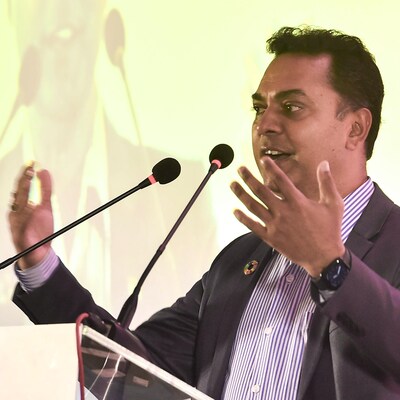[ad_1]
)
Kolkata: International Monetary Fund (IMF) Executive Director Krishnamurthy Subramanian addresses the conference ‘India @ 100 Building a US $55 Trillion Economy’, in Kolkata, Wednesday, Aug. 21, 2024. (Photo: PTI)
State governments need to boost reforms and come out with good policies, not just freebies, Krishnamurthy Subramanian, executive director at the International Monetary Fund (IMF), said in Kolkata on Wednesday.
Over the last 30 years, the central government irrespective of the political hue had done far better in terms of reforms, the former Chief Economic Advisor said at an event organised by CII Suresh Neotia Centre of Excellence for Leadership.
“But states need to really start pulling up their socks now. It’s governance at the state level that really needs to shape up,” he said at a CII event in Kolkata.
“It is time now that state governments also work hard in giving us reforms, good policies, not just freebies,” he added.
Subramanian, who was delivering a lecture on ‘India@100: Building a $55 trillion economy’, pointed out, “India is a federal structure. When there is conversation on reforms, policy, governance, all the spotlight is put on the central government. But equally we need to be putting the spotlight on states as well because power and responsibility are but two sides of the same coin.”
Subramanian, who believes that India has the potential to become a $55 trillion economy by 2047, said, in the next 25 years, there will be headwinds and tailwinds.
Among the potential headwinds, he said, climate change was one.
Advanced economies grew by using fossil fuels, accounting for 90-95 per cent of cumulative GHG emissions, he said. “While the cause of climate change is elsewhere, the outcomes of climate change are actually borne by us, the poor in particular.”
Subramanian noted that “good movement” had happened in creating social safety nets such as Ayushman Bharat, PM-Kisan. Some of these are actually critical but we need to invest more.”
He highlighted the importance of creating social safety nets using technology AI, machine learning for identifying natural disasters before they come.
Pointing to the role of states, he said, it was important that states think about urbanisation, especially the real estate permissions that they give.
“In many cities we’ve had this phenomenon of water bodies being filled up and tall structures coming up. This is not something that the central governments can do, the onus is on state governments.”
Subramanian said, if the Indian economy can grow at 8 per cent in real terms, then it will be a $55 trillion economy in 2047.
“Over the last 30 years the rate of growth in real terms has been close to 7 per cent. 8 per cent is a stretch goal – it is ambitious but achievable,” he said.
There were three growth drivers, formalisation of the economy was one, he said.
“When you look at advanced economies, their growth has come primarily from productivity improvements in the formal sector firms,” he said.
A large part of the Indian economy was still informal, he said, adding, “Firms in the informal sector are far less productive than firms in the formal sector. Formalisation increases productivity and that’s a key driver.”
Further, he said, even in the formal sector, firms were still not as productive as their global peers.
“This therefore provides another opportunity given the momentum that is there in innovation and entrepreneurship over the last several years.”
“A combination of innovation and entrepreneurship will lead to improvement in productivity,” he added, urging the private sector to spend more on research and development.
Pointing to the private credit to GDP ratio, he said, “In 2020, the ratio of private credit to GDP in India was 58 per cent. The global average for private credit to GDP ratio in 1960 was 60 per cent. We are still six decades behind, there is a huge runway that we have for increasing credit creation.”
First Published: Aug 21 2024 | 9:57 PM IS
[ad_2]
Source link

